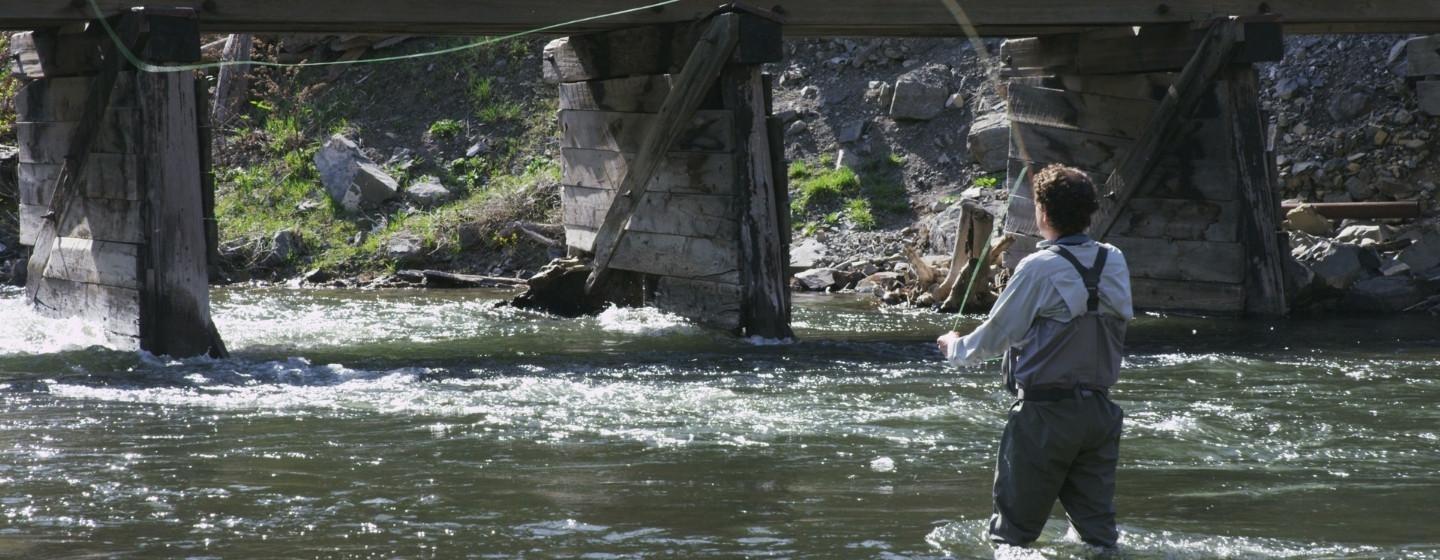Western NC’s Trout Fishing Industry After Helene


There’s always the question of whether a fish will bite a baited hook once it’s dropped in the water. It’s part of what makes fishing so enjoyable.
But in the first spring trout-fishing season since Hurricane Helene brought historic rains and flooding to western North Carolina, the question is not only whether the trout will bite but whether any trout are in the stream at all.
Many people are counting on it because trout fishing is big business in the region. A 2023 report shows trout fishing in the western NC mountains is a $1.38 billion industry. The agency estimates roughly 370,000 people visit the region for fishing.
Much of the trout that anglers in western North Carolina fish is stocked through the state’s Public Mountain Trout Waters Program. The program manages about 5,400 miles and 2,600 acres of trout waters in 26 western NC counties and encourages trout fishing as a heritage tourism industry. State hatcheries produce and stock about 1 million brook, rainbow and brown trout each year. The program also helps manage wild, self-sustaining trout populations, stream habitat and aquatic nuisance species management.
But the storm devastated trout fisheries and habitats, and the combination of debris and waterway changes have made some anglers’ favorite fishing rivers inaccessible for the season, which usually peaks in the spring and fall. Fishing is allowed in some areas year-round.
NCWRC is still assessing rivers and streams to determine whether stocking trucks and anglers can safely access the waterways. The agency, however, says trout stocking will be limited.
“We’re definitely anxious to see how things are doing and getting efforts back to the levels that anglers have come to expect over the years,” Jacob Rash, a coldwater research biologist with NCWRC, told Blue Ridge Public Radio. “We do know how important, whether its stock trout or wild trout, [trout] really are to everybody.”
NCWRC operates six fish hatcheries throughout the state that raise a variety of fish for stocking in the state’s public waters. The hatcheries are designated as warmwater, coolwater and coldwater hatcheries.
Helene knocked out the Armstrong State Fish Hatchery in McDowell County, north of Marion, which helps restock much of the trout in western NC’s mountain streams. The facility lost at least 600,000 fish when it was hit by landslides and flooding. That included broodstock, which are used for breeding. Because of damage to the facility access roads and the amount of debris left by the storm, the hatchery will be closed until January 2026.
The planned renovation at Bobby N. Setzer Fish Hatchery, NCWRC’s largest trout-producing hatchery, has been delayed until 2026 to help make up for some of the supply lost at the Armstrong facility. The Marion State Fish Hatchery, also north of Marion, and Table Rock Hatchery, near Morganton, received limited damage from Helene and have reopened. The Table Rock Hatchery is the division’s only coolwater hatchery and raises muskellunge, walleye and smallmouth bass as well as trout.
The Eastern Band of Cherokee Indians also operates a fish hatchery that helps stock the Straight Fork River in the Qualla Boundary. It’s estimated 30,000 rainbow trout were lost when Hurricane Helene’s water flooded the facility.
Helene’s impact on brook trout, the only trout native to the region, is still in question. Northern and southern breeds are found in the high-altitude headwater streams in the mountains. The fish like the oxygen-rich and pollution-free environments.
“The real challenges will be these places that saw landslides and debris flows, where it was just so much more than just water,” Rash told the Asheville Citizen Times.
To make matters worse, trout reproduce in the fall, and Helene hit just before the fall spawning period started. Biologists say if the fish were able to survive the storm, they may have been able to spawn and continue the normal life cycle. But if their eggs had already been laid, it’s doubtful they survived.
Rash adds that the good news is “nature is pretty resilient,” though he admits it may take years to restore the fish populations to what the numbers were pre-Helene. NCWRC is working to address access to rivers, habitats and fish populations.
To find out whether a specific access point will be open for trout-fishing season, search for a location on NCWRC’s trout stocking maps.
To learn about efforts to save a native fish in the Cape Fear River, watch this Sci NC story.